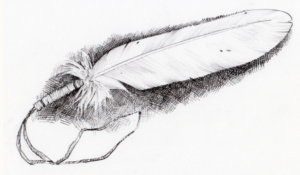
The National Eagle Repository
By: Mark McCollough
Life as a bird rehabilitator is not always pleasant. On a day in May, Marc Payne and Diane Winn at Avian Haven said goodbye to an old friend. A month before, an adult bald eagle was found floundering on the shore near Mount Desert Island.
It did not resist capture by Warden Joe McBrine. Multiple wounds on the wing and right leg indicated the bird was injured in a territorial dispute. This was no ordinary eagle.
It was wearing a heavily worn aluminum band. Tracing the faded numbers, 629-12255, Marc and Diane learned it was banded by Maine’s eagle biologist, Charlie Todd, in a nest in New Brunswick in 1983. At 36-years-old, this eagle was the oldest known living eagle in Maine!
Unfortunately, the old eagle did not recover from its injuries. It was deemed non-releasable. Marc and Diane hoped to keep the mild-mannered bird at their facility as a surrogate to help calm other eagles that were healing, but it developed osteoarthritis in the left knee and could not stand.
Its quality of life in captivity was no longer deemed possible. A difficult decision was made to euthanize the eagle. However, this is not the end of this eagle’s story.
Somewhere in this country, it is still soaring. By federal law, you and I cannot possess eagle feathers or parts. Native Americans are the only people who can.
In 1994, after meeting with 300 tribal leaders, President Bill Clinton signed an executive order requiring all deceased eagles to be sent to the National Eagle Repository. Eagles have long held great importance among Native Americans. They can obtain a permit to get the carcasses and feathers of bald and golden eagles for religious and cultural ceremonies.
Maine Inland Fisheries and Wildlife froze and carefully packaged Maine’s oldest eagle. It was sent with other deceased eagles to the National Eagle Repository located at the Rocky Mountain Arsenal National Wildlife Refuge near Denver in early summer. There U.S. Fish and Wildlife Service forensic biologists clean and carefully prepare eagle carcasses for shipping across the county to tribal members.
The eagle remains are used to create intricate headdresses, dance shawls, and other pieces for religious and cultural ceremonies. Many eagles have made the return trip to Maine to be distributed among the Penobscot, Passamaquoddy, Micmac, and Maliseet tribes. Sometimes tribal elders apply to the repository and disperse feathers to honor other members.
Using eagle parts in ceremonies is a long-held tradition for nearly all North American tribes. Eagle feathers are revered. Some are passed down through many generations.
Some tribes use eagle wings to bless newborns and guide the souls of those who have recently died. For many tribes, eagles possess tremendous power to heal, giving people strength, courage, wisdom, and generosity. Eagle feathers are highly esteemed and kept in a sacred manner until used at a time or prayer or ceremony. Accepting an eagle feather is one of the highest honors a Native American can receive.
Any tribal member over 18 can apply to receive up to one whole golden or bald eagle, or pieces equivalent to what one single eagle would contain, like a pair of wings, a tail, and a pair of talons. Each year the repository receives about 3,500 eagles and fulfills about 4,500 orders. Demand is high, with a two-year waiting list for tribal requests to be fulfilled.
Eagle carcasses come to the repository in all conditions. Long decomposed carcasses found on remote Maine islands have been carefully gathered and sent to the repository. Eagles hit while feeding on a road-killed deer on Interstate 95 may not be entirely salvageable but are sent to Colorado.
Sometimes, not all parts of these damaged eagles can be distributed. This year, the National Eagle Repository staff worked with tribal leaders to determine what to do with hundreds of eagles’ incinerated unusable remains. Colorado tribal leaders organized an interment ceremony.
The ashes of eagles from across the country were fed to the breeze in a remote mountain setting. First, one eagle appeared soaring overhead. Then, two. Eventually, five eagles cavorted and wheeled above the Native Americans welcoming their brethren back into the gossamer Rocky Mountain sky.
We don’t know where Maine’s oldest eagle now resides. It could be incorporated into regalia by a member of the Aroostook Band of Micmac or the Zuni Tribe of New Mexico. Wherever it exists, it is a revered possession. It will soar among the hopes and dreams of Native Americans for generations to come.
Mark McCollough is a wildlife biologist in Maine. He spent much of his career helping Maine’s eagle population recover. He saw eagle 629-12255 many times at winter feeding stations in eastern Maine in the mid-1980s. He can be reached at [email protected].


